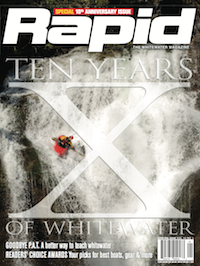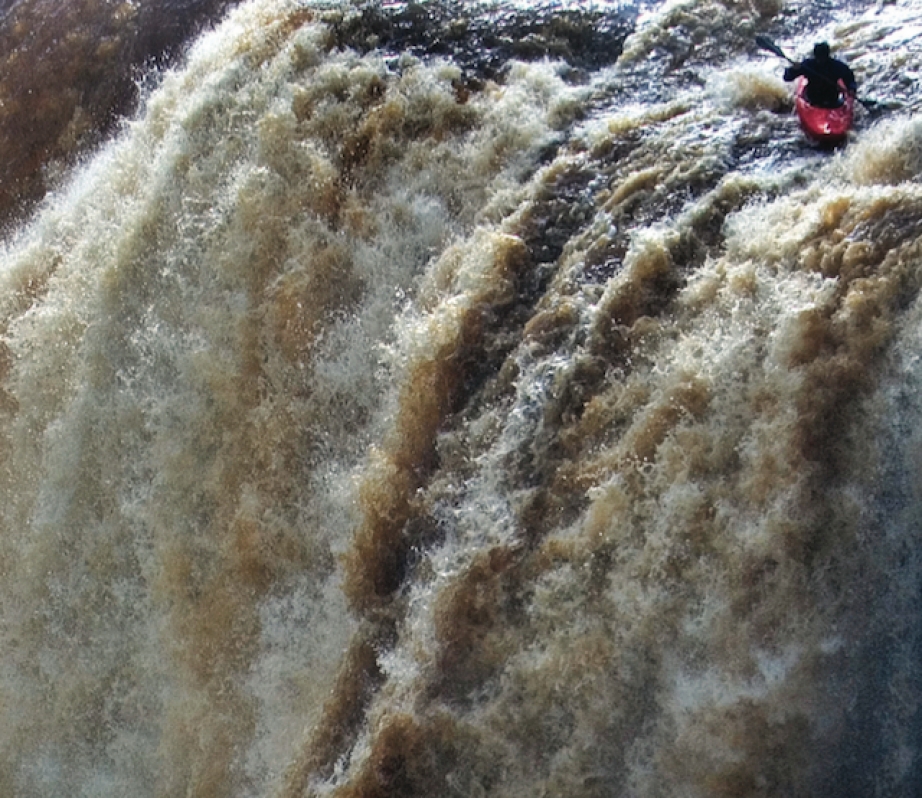While athletes trained for the World Rock Paper Scissors Society’s RPS Championships in Toronto, Tyler Bradt and Rush Sturges stood above 105.6-foot Alexandra Falls, just north of the Northwest Territories-Alberta border. They faced one another, pumped twice (official North American rules; in Europe they pump three times) and delivered their throws to decide who’d be first off the lip.
It’d been nearly a decade since Tao Berman set the world waterfall record with his 98.4-foot descent of Upper Johnston Falls outside Banff, Alberta. In 2003, steep creeker Ed Lucero ran Alexandra Falls, the highest waterfall attempted and survived, but he was spit from his kayak so many discounted this as a record.
“It’s a pretty serious waterfall, but I saw myself taking it clean,”
Bradt says from his cell phone, somewhere on US Route 89 between a creeking expedition in Mexico and his home in Montana. “Poor Rush felt the same, but we leave it up to fate and make all our decisions with Rock Paper Scissors.” Bradt threw scissors to Sturges’ paper and so climbed into his Dagger Nomad to break the world vertical waterfall record.
It is worth noting the Official Handbook of RPS Play states, “The result of a game is considered a binding agreement between the players.” Although a word of caution, it also states, “Think twice before using RPS for life-threatening decisions.”
Bradt’s chosen line was from river left, landing him in what he called a cushy foam pile. “It was a lot softer landing than I expected,” he admits. “The main thing I felt was a big slap in my face as my skirt exploded. I surfaced so fast there was hardly any water in my boat.”
Sturges landed to the right, his skirt imploded on impact and he was sucked behind the falls. After a squirrelly 30 seconds and several attempts to swim through the curtain Sturges emerged safely downstream.
Bradt says it’s these equipment failings that prevent the record from climbing much higher. But he hopes to change this.
Before kicking off the African Revolutions Tour in January, Bradt worked with the Department of Physics at Lewis and Clark College in Portland, Oregon, on its study Impact Forces Associated with Whitewater Kayaking.
This study uses data from NASA and an accelerometer within a kayak to calculate the G-forces acting on the human body off of a variety of waterfalls. The researchers say the vertical waterfall limit physically possible in kayaking is 186 feet (60 metres), taking into account current safety equipment and gear.
“Of course there are a lot of variables to consider, but theoretically we could push this beyond 266 feet,” Bradt laughs sinisterly. “Our equipment and boats just aren’t there yet.”
On his Revolutions Tour Bradt is testing under-seat suspension to absorb impacts and an implosion-proof skirt using a cable-release system.
“It’s a progression we need so we can achieve another level of safety for everyone, not just guys running the big stuff,” Bradt says. “Obviously there’s a lot of quirks and limitations but we need to discover those so we can usher in a new stage of development for creeking.”

This article first appeared in the Spring 2008 issue of Rapid Magazine.




